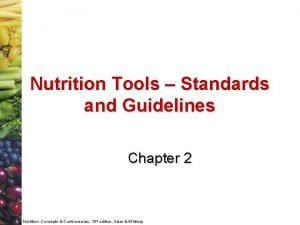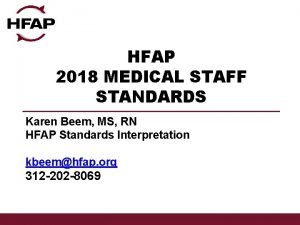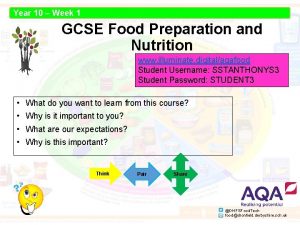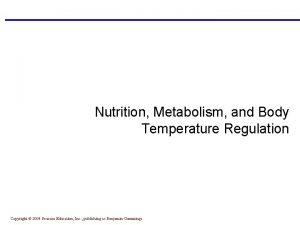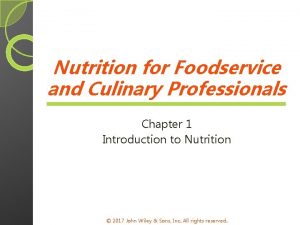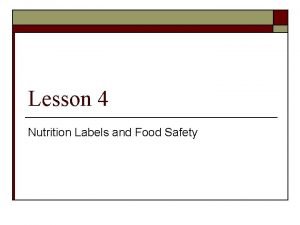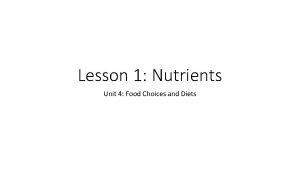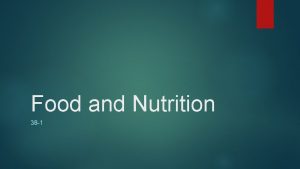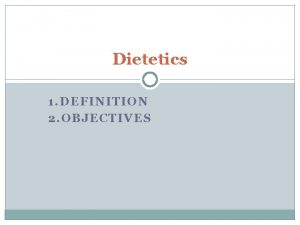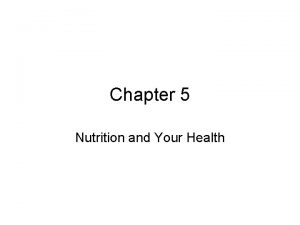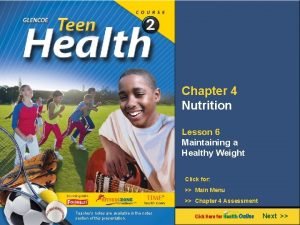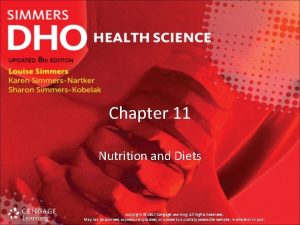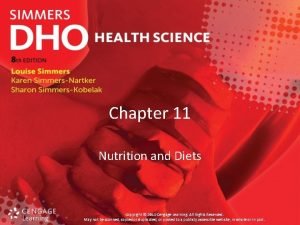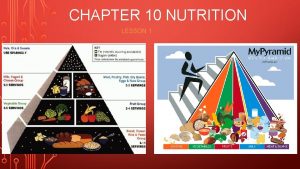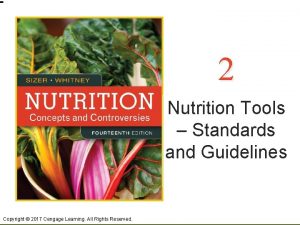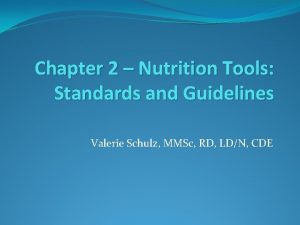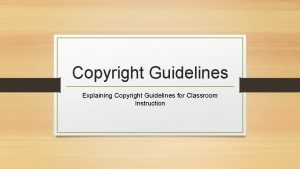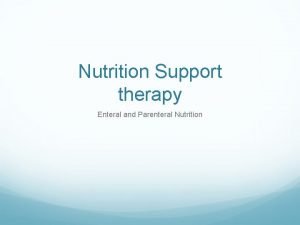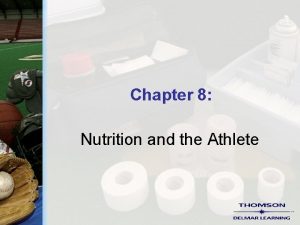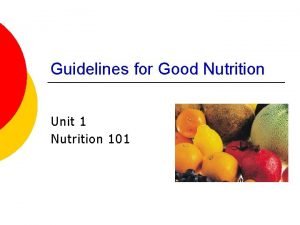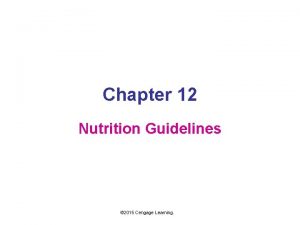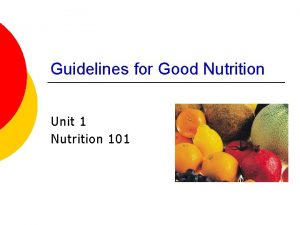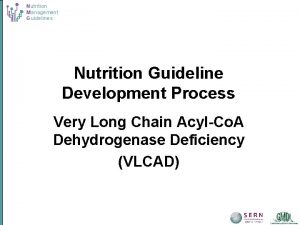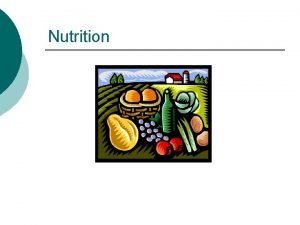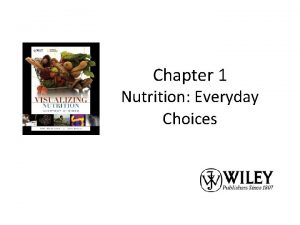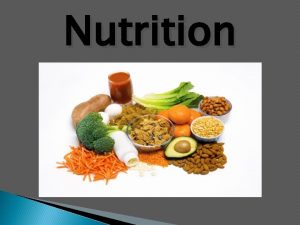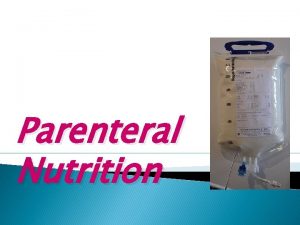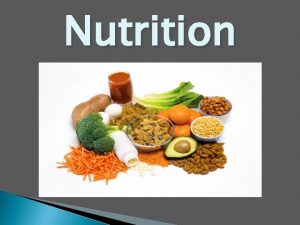2 Nutrition Tools Standards and Guidelines Copyright 2017




































- Slides: 36

2 Nutrition Tools – Standards and Guidelines Copyright © 2017 Cengage Learning. All Rights Reserved.

Nutrient Recommendations • Standards for healthy people’s energy and nutrient intakes • Dietary Reference Intakes (DRI) – Set values • Daily Values – Used on food labels; compare nutrient contents Copyright © 2017 Cengage Learning. All Rights Reserved.

The DRI Lists and Purposes • Recommended Dietary Allowances (RDA) and Adequate Intakes (AI) • Tolerable Upper Intake Levels (UL) • Estimated Average Requirements (EAR) • Acceptable Macronutrient Distribution Ranges (AMDR) Copyright © 2017 Cengage Learning. All Rights Reserved.

RDA and AI – Recommended Nutrient Intakes • RDA – Meet needs of almost all healthy people • AI • EAR – Assess nutrient intake of populations – Set recommendations for different life stage and gender groups • UL – Absence of UL • Indicates insufficient data to establish Copyright © 2017 Cengage Learning. All Rights Reserved.

The Naïve View Versus the Accurate View of Optimal Nutrient Intakes Copyright © 2017 Cengage Learning. All Rights Reserved.

AMDR – Calorie Percentage Ranges • Intake ranges for energy-yielding nutrients • Reduced risk of chronic disease • Expressed as percentage of total Copyright © 2017 Cengage Learning. All Rights Reserved.

Understanding the DRI Recommended Intakes • Differences between individuals – Recommendations for populations (men, women, pregnant or lactating women, infants, and children, and age ranges) • Adequate intake over time • Characteristics of the DRI – Optimum intakes, not minimums • DRI apply to healthy people only Copyright © 2017 Cengage Learning. All Rights Reserved.

Setting Energy Requirements • Estimated Energy Requirements (EER) – Apply to individual of particular age, gender, height, weight, and activity level Copyright © 2017 Cengage Learning. All Rights Reserved.

Daily Values • Found on food labels • Reflect highest nutrient need among all population groups • Reflects the needs of someone consuming 2000 -2500 calories/day Copyright © 2017 Cengage Learning. All Rights Reserved.

Dietary Guidelines for Americans Table 2 -1 • Food-based strategies for achieving the DRI values – Healthy eating pattern across the lifespan – Focus on variety, nutrient density, and amount – Limit calories from added sugars and saturated fats and reduce sodium intake – Shift to healthier food and beverage choices • Key Recommendations Copyright © 2017 Cengage Learning. All Rights Reserved.

Dietary Guidelines Shortfalls and Overconsumed Nutrients Copyright © 2017 Cengage Learning. All Rights Reserved.

How Does the Typical U. S. Diet Stack Up? We consume too many calories, too much red and processed meats, refined grains, added sugars, sodium, and saturated fats Copyright © 2017 Cengage Learning. All Rights Reserved.

Diet Planning with the USDA Food Intake Patterns • Food group plan • Following the USDA Eating patters will achieve adequacy, balance, moderation, and variety. Copyright © 2017 Cengage Learning. All Rights Reserved.

The Food Groups and Subgroups Copyright © 2017 Cengage Learning. All Rights Reserved.

The Food Groups and Subgroups (cont’d. ) Copyright © 2017 Cengage Learning. All Rights Reserved.

The Food Groups and Subgroups (cont’d. ) Copyright © 2017 Cengage Learning. All Rights Reserved.

Choosing Nutrient-Dense Foods • Nutrients provided per calorie food • Limit solid fats, added sugars, and alcohol – Empty calories Copyright © 2017 Cengage Learning. All Rights Reserved.

How Solid Fats and Added Sugars Add Calories to Nutrient-Dense Foods Copyright © 2017 Cengage Learning. All Rights Reserved.

Daily Amounts from Each Food Group Copyright © 2017 Cengage Learning. All Rights Reserved.

Weekly Amounts from Vegetables and Protein Foods Subgroups Copyright © 2017 Cengage Learning. All Rights Reserved.

A Sample Diet Plan Copyright © 2017 Cengage Learning. All Rights Reserved.

My. Plate Educational Tool • Online educational tool – www. choosemyplate. gov • Guides users through diet planning following USDA intakes • Flexibility of the USDA Food Patterns – Mixed dishes – National and cultural foods – Vegetarians • Make ½ plate fruits/veggies Copyright © 2017 Cengage Learning. All Rights Reserved.

Controlling Portion Sizes at Home and Away • Portion sizes may be difficult to judge – Restaurant portions have no standards • • Practice with weights and measures Buy smaller bowls Dining out trends Colossal Cuisine Copyright © 2017 Cengage Learning. All Rights Reserved.

Dining Out Trends Copyright © 2017 Cengage Learning. All Rights Reserved.

A Shift Toward Colossal Cuisine Copyright © 2017 Cengage Learning. All Rights Reserved.

Food Lists for Diabetes and Weight Management • Can be useful for anyone • Estimates grams of carbohydrate, fat, saturated fat, and protein in standard food portions • Averages for whole groups of foods • Appendix D Copyright © 2017 Cengage Learning. All Rights Reserved.

What’s on a Food Label? Copyright © 2017 Cengage Learning. All Rights Reserved.

FDA’s Proposed New Nutrition Facts Label Copyright © 2017 Cengage Learning. All Rights Reserved.

Label Claims Copyright © 2017 Cengage Learning. All Rights Reserved.

What Food Labels May Include Copyright © 2017 Cengage Learning. All Rights Reserved.

Facts Up Front • • Front of package labeling initiative Easy identification of key nutrition facts Voluntary Developed by food industry groups Copyright © 2017 Cengage Learning. All Rights Reserved.

Food Feature: Getting a Feel for Nutrients in Food • More nutrient dense • Provide necessary servings from each group Copyright © 2017 Cengage Learning. All Rights Reserved.

Food Feature: Getting a Feel for Nutrients in Food • No fruit or whole grain • Too much energy, saturated fat, not enough fiber Copyright © 2017 Cengage Learning. All Rights Reserved.

Controversy 2 – Are Some Foods Superfoods for Health? • Phytochemicals – Bioactive: alter body processes – Flavonoids – Antioxidants • Protect DNA from oxidative damage – Anti-inflammatory – Food is best and safest Copyright © 2017 Cengage Learning. All Rights Reserved.

Some Phytochemicals and Their Sources • Blueberries • Chocolate (Dark) • Flaxseed – Lignans and phytoestrogens • Garlic – Antioxidant organosulfur compounds Copyright © 2017 Cengage Learning. All Rights Reserved.

Some Phytochemicals and Their Sources (cont’d. ) • Soybeans and soy products – Chronic diseases – Downsides • Tomatoes – Antioxidant lycopene • Tea • Grapes and wine • Yogurt • Students need to find the health claims of each of the above mentioned foods and discuss downsides as well Copyright © 2017 Cengage Learning. All Rights Reserved.
 Healthypeopleenergy
Healthypeopleenergy Nutrition tools standards and guidelines
Nutrition tools standards and guidelines Chapter 5 nutrition guidelines tools for healthful eating
Chapter 5 nutrition guidelines tools for healthful eating Copyright and fair use guidelines for teachers
Copyright and fair use guidelines for teachers Copyright secondary sara (2017) answers
Copyright secondary sara (2017) answers Banc plus
Banc plus American thyroid association guidelines pregnancy 2017
American thyroid association guidelines pregnancy 2017 European quality assurance standards
European quality assurance standards Hfap 2017
Hfap 2017 2017 english standards of learning curriculum framework
2017 english standards of learning curriculum framework Customer service standards table
Customer service standards table Office developer tools for visual studio 2017
Office developer tools for visual studio 2017 Visual studio code oracle
Visual studio code oracle What are national core standards
What are national core standards Marking tools in sewing
Marking tools in sewing Pros and cons of artificial nutrition and hydration
Pros and cons of artificial nutrition and hydration Patent and copyright difference
Patent and copyright difference What is the copyright designs and patents act 1988
What is the copyright designs and patents act 1988 Copyright designs and patents act 1988 examples
Copyright designs and patents act 1988 examples I the lord of sea and sky copyright
I the lord of sea and sky copyright Illuminate aqa food preparation and nutrition
Illuminate aqa food preparation and nutrition Temperature regulation
Temperature regulation Nutrition for foodservice and culinary professionals
Nutrition for foodservice and culinary professionals Kelsey carbonetta
Kelsey carbonetta Datingoo
Datingoo Food and nutrition unit 4
Food and nutrition unit 4 38-2 the process of digestion
38-2 the process of digestion Food and nutrition unit 4
Food and nutrition unit 4 Section 38-1 food and nutrition
Section 38-1 food and nutrition Objectives of dietetics
Objectives of dietetics Chapter 7 nutrition and your fitness
Chapter 7 nutrition and your fitness Chapter 5 lesson 1 health
Chapter 5 lesson 1 health Unit 3 lesson 6 anorexia nervosa and bulimia
Unit 3 lesson 6 anorexia nervosa and bulimia Chapter 4 nutrition and your personal fitness
Chapter 4 nutrition and your personal fitness Dho chapter 11 nutrition and diets
Dho chapter 11 nutrition and diets Test chapter 11 nutrition and diets
Test chapter 11 nutrition and diets Chapter 10 nutrition for health lesson 1 answer key
Chapter 10 nutrition for health lesson 1 answer key
